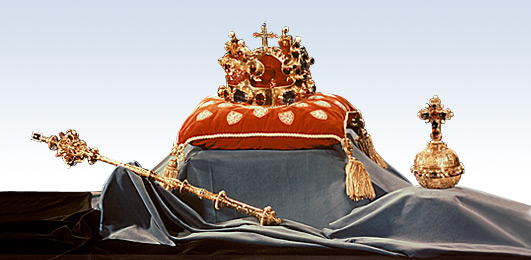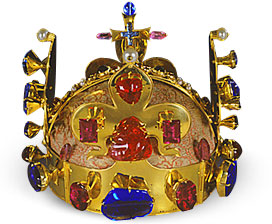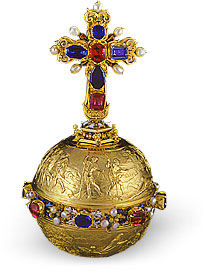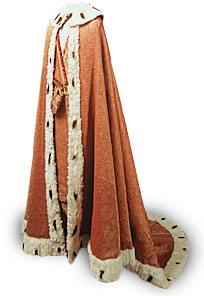The Bohemian Crown Jewels
Prague Castle, as well as its protected area which also includes archaeological findings, are No. 1 recognized parts of the Czech cultural heritage. The Bohemian Crown Jewels rank second to this national bequest. The Crown Jewels are permanently safely kept at Prague Castle and may be displayed exclusively in its area. But this occurs only on quite exceptional occasions. Nowadays, the Jewels are usually displayed once every five years. The President of the Republic has the exclusive right to decide on the display of the Crown Jewels.
The Crown Jewels chamber in St. Vitus Cathedral, where the Crown Jewels of Czech kings are, is under lock and key, and without exaggerating it is the place least accessible at Prague Castle. The door, and likewise the iron safe, has seven locks and there are seven holders of the keys: the President of the Republic, the Prime Minister, the Prague Archbishop, the Chairman of the House of Deputies, the Chairman of the Senate, the Dean of the Metropolitan Chapter of St. Vitus Cathedral and the Lord Mayor of Prague, who must all convene to facilitate opening of the impenetrable door and coffer.

Copies of the Crown Jewels can be seen in the Old Royal Palace.
The tradition of the seven keys was established in 1791 by King Leopold II when he agreed to comply with the wish of the Czech Estates to return the jewels to Prague from Vienna. They were put safely into St. Vitus Cathedral at Prague Castle, this time in the crown archives beyond the St. Wenceslas Chapel behind iron bars with five locks. They were placed in a special chest with additional two locks, the two keys to which were given to two guards of the jewels. Even though the jewels were later moved to another location, the tradition of the seven keys has been maintained.
The value of the Bohemian Crown Jewels can in no way be expressed in terms of money. Apart from possessing priceless historic value, they have also become a rare symbol of Czech statehood.
The set of Crown Jewels consists of the St. Wenceslas Crown including a casket and cushion, the Royal Sceptre and its casket, the Royal Apple and its casket, the Coronation Cloak and other pieces of attire: a belt, a maniple (an ornamental band worn on the left arm by the celebrant of the Eucharist), a stole and ermine collar. In the Middle Ages the items also included a ring, golden bracelets and a crystal vessel for holy oil.
St. Wenceslas Crown

The St. Wenceslas Crown - wrought of extremely pure gold (21 -22 carat), decorated with precious stones and pearls - is the oldest item of the Crown Jewels. It weighs almost two and a half kilos and, including the cross, reaches a height of 19 cm. Likewise its diameter is 19 cm and each of the four parts of the headband measures 14.5 cm. Charles IV had it made for his coronation in 1347 and forthwith he dedicated it to the first patron saint of the country, St. Wenceslas, and bequeathed it as a state crown for the coronation of future Czech kings, his successors to the Czech throne. However, perhaps to the end of his days (1378) he continually had the Crown altered and set with additional rare precious stones he managed to acquire. And so the crown developed into its final contemporary image.
In shape this Crown is related to the previous crown of the Premyslides and the kings of France. The Crown is similar to a headband of four sections, each of which reaches its zenith with a large lily. The sections are connected at the top by two arches to which jewels (from headbands or diadems) of earlier days are attached. At the apex of the Crown, where the arches meet, there is a golden cross with a sapphire cameo, an engraving decorated with precious stones. The Crown contains a total of 19 sapphires, 44 spinels, 1 ruby, 30 emeralds and 20 pearls.
On the orders of Charles IV, the new Royal Crown was to be permanently deposited in St. Vitus Cathedral. But his immediate successor, his son Vaclav IV, probably at the beginning of the 15th century, had the Crown Jewels moved to Karlstejn Castle, where the crown was supposed to be in safe keeping in the unsettled times of strife among those ambitious to grasp power. Since then the location of the Crown Jewels has changed many times, usually at moments of political unrest, when there were struggles to gain the Czech throne and when there was a danger of war. The stormy 17th century decided on the dramatic fate of the Crown Jewels. The location where they were placed changed several times. For a while the Crown Jewels were again deposited in St. Vitus Cathedral, then in the office of Land Rolls, then in the Old Town Hall. In times when Prague was threatened, the jewels were even hidden in Ceske Budejovice. The Habsburg dynasty determined a more permanent location for the jewels in Vienna where they remained until the end of the 18th century. But wherever they were deposited, be it at Karlstejn or in Vienna, they were always brought to Bohemia, to Prague Castle, for royal coronations.
The golden Royal Apple and Royal Sceptre, which are now an integral part of the Czech Crown Jewels, hail from much later times than the St. Wenceslas Crown, which takes a dominant place among the set of Crown Jewels. Unlike the Crown, the Apple and Sceptre did not command independent attention in spite of the fact that these are very significant and unique examples of jewellery wrought during the Renaissance. They are considered to have been made in the first half of the 16th century, probably in the reign of Ferdinand I who was crowned King of Bohemia in 1527, Roman king in 1531 and Emperor in 1556.

The Apple wrought of fine gold (18 carat), weighs 780 grams and measures 22 cm in height. It consists of two flattened hemispheres linked by a decorative circular band and crowned with a fairly large cross. The circle under the cross bears the inscription DOMINE IN VIRTUTE TUA LETABITUR REX ET SUPER SALUTARE TUAM EXULTABIT (O Lord, in Thy strength the king will be glad and in Thy salvation how greatly he will rejoice). The richly ornamented decorations feature predominantly precious stones and pearls, while the slight little figures of six sphinxes on the base of the cross form a charming detail. The gold, the red spinels, and the blue sapphires, in places emphasized by colourful enamel are striking in their harmony. The surface of both hemispheres is covered with an extremely precisely wrought relief of figures, thematically connected with the coronation. On the upper hemisphere there are scenes illustrating the story of David - him anointed king and the fight between David and Goliath; on the lower hemisphere there is a depiction from Genesis of Adam kneeling before the Creator, of Adam being led into the Garden of Eden, and the Creator warning Adam and Eve of the tree of knowledge. The use of these areas for figural decoration is unique and indicates the significance attributed to this insignia by the person who commissioned it.

The Sceptre is wrought of gold of equal purity as the Royal Apple. It is 67 cm long and weighs 1,013 grams. In the set of Crown Jewels, this Sceptre and Apple replaced older ones from the time of the rule of Charles IV. It is decorated with four sapphires, five spinels and sixty-two pearls. It consists of several differently shaped parts connected with rings, with a more striking feature of a row of pearls at the base of the handle. The entire surface of all the parts is covered by a finely engraved decoration whose dominant feature consists in the motive of vine tendrils, leaves, and flowers or acanthuses. Some parts, in addition, are overlaid with multi-coloured enamel. The spectacular crest of the Sceptre is modelled in the shape of a kind of a flower with S-shaped stems and fine acanthuses from which gems and pearls sprout.
 The Coronation Cloak, which has been preserved at Prague Castle, is made of luxurious silk material, called gold lily. A pattern of the cloth is made of a silk thread wound around a flat golden wire (purl). The design of the cloak itself is semi-circular, without sleeves, prolonged at the back to form a train. It is 312 cm wide and measures in length 236 cm from the neckline to the end of the train. It is entirely edged with ermine - the white winter coat of a stoat - which, because it is so precious and rare, is considered to be the fur of kings. Researchers have succeeded in dating it more precisely to the beginning of the 17th century, probably worn in the reign of Ferdinand II. He was crowned the Czech king in 1617, and as it has been recorded, was clothed in a "gold-lily cloak". The last king to be clad in the Czech coronation attire was Ferdinand V when he was crowned the Czech king in 1836. Since then, the coronation apparel is only of historical and art-historical significance. It does, however, highlight a unique collection of rulers' apparel and their fragments, which have been preserved at Prague Castle since the 10th century.
The Coronation Cloak, which has been preserved at Prague Castle, is made of luxurious silk material, called gold lily. A pattern of the cloth is made of a silk thread wound around a flat golden wire (purl). The design of the cloak itself is semi-circular, without sleeves, prolonged at the back to form a train. It is 312 cm wide and measures in length 236 cm from the neckline to the end of the train. It is entirely edged with ermine - the white winter coat of a stoat - which, because it is so precious and rare, is considered to be the fur of kings. Researchers have succeeded in dating it more precisely to the beginning of the 17th century, probably worn in the reign of Ferdinand II. He was crowned the Czech king in 1617, and as it has been recorded, was clothed in a "gold-lily cloak". The last king to be clad in the Czech coronation attire was Ferdinand V when he was crowned the Czech king in 1836. Since then, the coronation apparel is only of historical and art-historical significance. It does, however, highlight a unique collection of rulers' apparel and their fragments, which have been preserved at Prague Castle since the 10th century.
